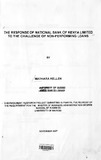| dc.description.abstract | All firms exist in a complex network of environmental forces, which are so dynamic
that they continuously present threats and opportunities. Consequently, all firms
have to continuously monitor and adapt to the environment. In this environmental
dependency, firms depend on the environment for inputs and also for a market for
their output. The aim of adaptation is to align the firm's strategy and capability to the
changing environment. Ultimately, a firm's strategy must match the environmental
realities and at the same time, the firm's capabilities must match the strategy.
The objective of this study was to establish the causes and responses of National
Bank of Kenya to the challenge of non-performing loans (NPLs). Towards this end,
the study collected both primary and secondary data. The primary data was
collected from six top managers of the bank, who comprised two general managers,
two immediate retired general managers and two senior managers. Secondary data
was largely collected from Central Bank of Kenya publications to augment and
support the primary data.
The study established six external factors as the causes of NPLs, which include
economic downturn, government interference on lending and debt collection,
inflationary tendencies, limited supervision by the Central Bank of Kenya (CBK),
inadequate government monetary policies and a slow judicial system. The internal
factors include poor management, poor risk management practices, poor monitoring
and evaluation systems, lack of management's accountability for bad debts, reckless
lending, lack of adequate credit policy guidelines and a diversified loan portfolio.
The study also identified five major challenges posed by NPLs. These include
liquidity problems, low profitability, bad public image, and problems with debt
collection. The pressure to respond emanated from both the internal and external
environment. Liquidity problem was the only internal force identified by the respondents. The real impetus seems to have emanated from external sources.
These forces include pressure from shareholders, Central Bank of Kenya,
competitors, the stock exchange, bad publicity, and economic recession.
Further the study identified six responses of the bank to the challenge of NPLs.
These include change of leadership, turnaround strategy comprising both
retrenchment and restructuring of the bank, culture change, re-capitalization of the
bank, technology enhancement and marketing initiatives.
It was conclusive that the bank had responded to the challenge of NPLs. However,
most respondents did not consider the responses as having achieved optimum
results owing to problems at implementation stage. The bank's strategies were
mostly planned strategies, which originated from the top management, with little staff
participation and involvement. Consequently, the implementation logistics took time
to re-configure from the original strategy, in order to reflect operational realities. In
essence what was eventually realized was an interplay between the planned and
emergent strategies.
The study therefore recommends more staff involvement and participation in the
strategy making processes. Additionally, the bank should be more proactive by
ensuring prudent credit risk management and also closer monitoring of the existing
debts in order to ensure that future incidences of NPLs are minimized.
Few studies have been previously conducted on the problem of NPLs. In particular,
the researcher has no knowledge of any survey conducted on state owned banks to
establish the causes of NPLs. The study therefore, recommends such a survey to
be conducted on NBK, KCB, Co-operative Bank and Consolidated bank, in order to
allow generalizations to be made. This may assist reduce future occurrences of
NPLs in Kenya. | en |

